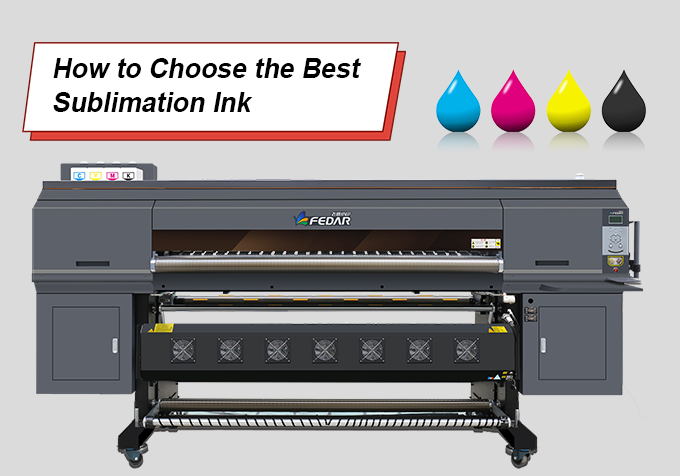09
Sep

In the magical world of sublimation, getting everything right matters. Choosing a printer that suits your needs, a high-quality compatible sublimation paper, the right substrate, and last but not least, the best sublimation ink might seem like a challenge at first. But not to worry! In this article, we’ll help you learn the basics of sublimation ink so you can walk through the maze of sublimation easily.
Sublimation inks are solid dye-based inks specially designed for sublimation printing. The ink is transferred onto a special receiving paper to be printed onto a substrate under a heat press. Sublimation ink is different than other inks as it transforms into a gas under heat and pressure, bypassing the liquid phase.
Sublimation ink permeates the substrate material and chemically bonds with it, producing vibrant, crisp, and durable results. The print doesn’t sit on top of the material like traditional prints but instead becomes one with it. The versatility and durability of these inks make them popular among business owners and hobbyists.
Different brands and types of sublimation inks have their particular characteristics. With so many sublimation ink options available, making the right choice can be confusing. The type of ink you choose will significantly affect how your final print turns out and how efficiently your printer functions.
You can go through the following few checks to make sure that you get amazing results in your printing adventures:
When it comes to sublimation inks, all are not created equal. You must ensure that your sublimation ink is compatible with your printer model. Ink compatibility facilitates smooth operations, producing vivid, long-lasting, high-quality prints.
Choose an ink that has good anti-sedimentation characteristics. Dye sedimentation in ink can cause printhead clogging, leading to hardware malfunction and subpar prints.
The sublimation ink you choose should have a good flow so that it doesn't break throughout the process and gives seamless results. Make sure sublimation ink is nanofiltered so it doesn’t leave residue in the ink, as residue can block or damage your printhead nozzles.
Sublimation printing works on thermal sublimation, so a high color reproduction rate is important in determining how your prints come out. A higher color reproduction rate means higher color saturation in the final print. An easy test for checking color reproduction can be done with black ink because it off-colors the most. Black inks often turn green or brown if the ink is low-quality, so if the black turns out exactly how you wanted, the ink is good to go.
Color-fastness is the ink’s resistance to fading or running. It is the binding force with which the ink adheres to a material. Also, ensure sublimation ink is moisture-resistant so it doesn't fade away with washing. Your prints should withstand high temperatures, scrubbing, friction, and sun exposure.
Side note: Always source your sublimation inks from a reputable vendor. Ensure that your inks are produced in an environmentally friendly way and are free from harmful substances.
Where traditional printing can be done directly, sublimation printing is usually a two-step process; the ink is printed on a special sublimation paper first. After this, the sublimation paper with the printed design is placed on the product. Finally, the product is put under a heat press for sublimation.
Heat and pressure cause the solid dye ink to turn gaseous, bypassing the liquid phase. The gaseous ink, in this method, forms a strong chemical bond with the material and gets immersed in its surface. The peculiarity of sublimation ink printing is that you can’t feel the print on the surface of the substrate; it gives an effect similar to dyeing.
Several types of sublimation inks are available on the market; your choice of ink depends upon the type of printer you’re working with and the material you choose to print on. Listed below are the most common types of sublimation inks:
Water-based sublimation inks are the most commonly used. They’re best for desktop sublimation printers. They’re environment-friendly and produce vibrant results.
Solvent-based inks are perfect for large industrial printers. Instead of a water base, these inks are based on a solvent carrier. These inks are great for high wear and tear because they’re durable.
Eco-solvent sublimation inks are getting popular as environmental consciousness gets traction. They have lower VOC emissions and thus are better for the environment. Eco solvent inks also reduce the wear and tear of your hardware components.
These inks are ideal if you desire high-quality and sharp images. They have a higher release rate from the nozzle, so there is more color saturation. The final prints come out sharper and more vivid.
These inks are most suited for printing on outdoor products like banners, boards, etc. They resist fading and withstand sunlight and extreme weather conditions.
Gel-based sublimation inks can only be used with printers that are specially designed for them. They offer high stability and sharp, vivid images.
The name is self-explanatory; these inks give a neon/fluorescent effect. Fluorescent inks are getting popular in the fashion and creative industries. They’re best for making eye-catching designs.
Sublimation printing is a mesmerizing process, but one that needs consistent learning. One needs to constantly upgrade one’s knowledge about all the components involved in the sublimation process to get perfect results consistently. The sublimation ink is responsible for most of the magic in sublimation printing, so make sure to get it right.
It is only natural to feel worried or anxious when you embark upon a new journey. Always remember to focus on learning and believe that every problem has a solution that you will figure out eventually. We wish you good luck with your next sublimation adventure!
If there's anything we can do to further showcase machines' features, please let us know.
